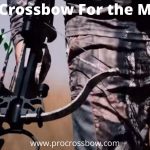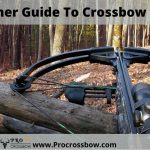Bowhunting is not a surefire way to harvest a deer or other trophy. You don’t know what you’ll see in the field when you leave. If you do not have the right arrows, nocks, and tips, you will not be able to take down the animal with the crossbow. To get the most from your tools in the woods, it’s good to learn about Crossbow Arrows Guide.
Crossbow Arrows Guide
Table of Contents
The crossbow projectile is sometimes called a bolt and, in some cases, an arrow. Even though both definitions are correct, we only use the word bolt when discussing crossbows instead of regular bows. Due to its unstable back, the bolt lacks a stabilizing vane. An arrow has a stabilizing vane. However, nowadays, both are the same thing when people mention them. Additionally, we have compiled the top youth crossbows.
Terminology for the Projectiles
Understanding what precisely a crossbow projectile, is the first step. Unlike arrows, bolts are only used with crossbows when they are used as projectiles. In contrast to bolts and arrows, arrows have to stabilize attachments on the back end.
What is a Fletching?
Fletching are part of bolts, along with nocks. As a result, they resemble wings on the rear of the bolt. The bolt becomes unstable when they are fired in the wrong direction. The fletching keep the bolt on its intended course rather than having it bounce back and forth. Today, bolts for sale usually have three wings, called vanes, which are little upward-pointing wings. Arrows for bows other than crossbows generally use feathers, but the bolt for a crossbow does not use feathers. The bolt often determines how long the fletching are, and the fletching are simply glued to the bolt.
Different of an arrow and specs
The average crossbow arrow is around 20 inches long. Most crossbow arrows measure 16 to 22 inches in length. Whenever you are shopping for a crossbow, you should always pay attention to the manufacturer’s instructions. The tip of shorter arrows would interfere with the rails of the crossbow, so it’s usually better to use arrows that are a bit longer. Likewise, you can also see this in the Hunting Seat Cushion category.
Parts of a crossbow arrow:
Arrows are essentially made up of the shaft, which is what gives them their shape. There is a connection between everything here. Various types of arrows are available today, including aluminum and copper arrows. These materials are resistant to bending, don’t splinter, and don’t splinter despite their lightweight. You can also combine the materials to make a product. A bolt’s spine consists of a variety of shafts of various stiffness. We refer to this weight as grains.
The Nock
Using a nock, it attaches to the shaft at the back. It is made from aluminum or plastic. As you are lining up for the shot, this item ensures the bolt stays in place so that the shot goes off smoothly. Half-moon notch and flat notch are the two types of the notch. You would ensure that your string matches the groove on the half-moon nock before firing the bolt. There are many different types of nocks available, and other manufacturers recommend different types. Whenever Barnett recommends you use moon-shaped nocks, he always means half-moon nocks. If you don’t know what you need, we recommend you contact the manufacturer.
The Fletching
A nock has several wings attached to it, one of which is located very close to the back of the bolt. Their function is to protect the nock. It helps stay on track with the bolt during its flight and prevent the bolt from ever drifting left or right. By adding these fletching, the arrow moves around the axis during flight, increasing the stability. There are usually 3 or even more fletching on the modern bolts. The most common kind of turning device is a plastic rotating disk. On crossbows, feathers were traditionally used as fletching, but they no longer are. Fletching are available in different lengths. There is no rule regarding what length is better, but always measure fletching length against arrow shaft length.
The Bolt Head
The other arrowhead type includes 3 main subtypes; there are 2 main types of arrowheads. Target practice is conducted at the field points, and the target practice points are known as field points. It isn’t a hunting knife because it has no sharp edge. There is a screw that holds the field points of the bolt shaft. The total weight of these grains is usually between 125 and 150 grams. It is important to ensure that the weight of the pointed replicas is the same as the weight of the actual field points. A broadhead is a similar but much more powerful piece of equipment. It is screwed into the shaft tip and is made specifically for hunting.
- Unlike detachable blades, fixed blade broadheads always have razor-sharp blades.
- You can easily remove the blades of a removable blade broadhead and easily replace them if necessary.
- To ensure maximum damage, it expands when the arrow hits the animal. We use expandable blade broadheads hidden inside these arrows as they are triggered by impact.
It is important to consider individual preferences when choosing broadheads. Every hunter must learn the crossbow arrows guide first to start their hunting. You need to consider the following 4 things:
- Ensure that the broadheads and field points are the same weight. You should also get the exact weight of your crossbow’s bolts and bolt heads.
- Using lighter arrow shafts or heads will decrease the performance of your bow. The heavier, the better, the lighter, the worse.
- Almost always, hunters must purchase hunting supplies in addition to crossbows. Today, most crossbows come with arrows and practice field points.
- If you use heavier arrows, your crossbow would have a lower velocity.
Conclusion
This guide should prove helpful to you. You can also let us know if it was through the comments below. Hunting is fun! Consider the crossbow you plan to use and the bolts you plan to use when you are ready to go shooting. The crossbow arrows guide become helpful. For your practice to be effective, your field points and broadhead weight must match. You should also ensure that bolts are always heavier than the recommended weight. Crossbow manufacturers never recommend lighter bolts because crossbows can malfunction or misfire, resulting in injury. You can expect to get bolts with field points when you buy your first crossbow.



